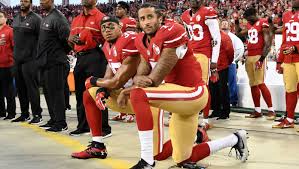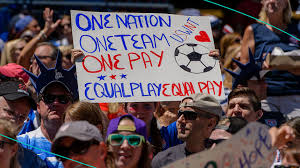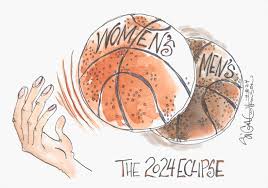Section One: The Fundamentals
A) What do we know about sport? What are common assumptions we make about sport and society?
Exercise 1: Before we go any further, I want you to take a moment and complete the phrases below:
While these statements might be true on one level, on another, they do not align with many people’s experience of sport, which brings us to our first class discussion forum.
Exercise 2: Padlet response
Speculate on why some of the statements/assumptions above might be untrue for some people or from a certain perspective. Is there anything your peers noted that surprised you? Comment on this as well.
[type below or paste in a screenshot of your padlet participation]
While many of these statements highlight the positive aspects of sport, they are not universally true and can be challenged from various perspectives. For instance, while sport is often credited with building character, it can also foster unethical behavior, such as excessive competitiveness, rule-breaking, or even corruption, particularly in high-stakes environments. Similarly, while sport is seen as a vehicle for social mobility, access to opportunities is not equal for all. Socioeconomic barriers, systemic discrimination, and unequal resource distribution can significantly limit participation and advancement, especially for marginalized communities.
The claim that sport “transcends politics” is also contentious. Historically, sports have been deeply intertwined with political movements, from the use of the Olympics for national propaganda to athletes leveraging their platforms to advocate for social justice. Rather than existing outside of politics, sport often serves as a reflection of broader societal and political issues.
One particularly interesting point raised by my peers was the notion that sport does not always foster unity. While it can bring people together, it can also create divisions through intense rivalries, exclusionary practices, or even instances of violence among fans. This perspective challenges the common assumption that sport is inherently a unifying force and highlights the complexity of its social impact.
|
Exercise 3: Notebook prompt
What are some other metanarratives about sport that you are familiar with? Find an image or video clip or draw something yourself that captures this idea…
So what? Why does any of this matter? Does it matter? As something we grow up with – live with – play through – we don’t often interrogate the meanings of sport, and perhaps we don’t want to.
But being aware of these assumptions and metanarratives is especially important, I would argue, because of the centrality of sport to our everyday lives, the role that sport plays in shaping our childhood and worldviews and….. [finish that thought]

To finish the tought: The way it reinforces broader social structures, including power dynamics, identity formation, and cultural values. Sport is not just a game, it reflects societal norms, economic inequalities, and even political tensions. By critically examining these metanarratives, we can better understand how sport influences no tions of success, competition, and inclusion, shaping both individual experiences and collective ideologies.
|
B) What is social justice?
Exercise 4: Padlet Prompt
Think back to the last section and try to look at some of the ideas we discussed differently. How might sport and social justice actually co-exist?
Record any images, video clips, or gifs you added to the padlet and identify a point of intersection between sport and social justice (can be an issue or a barrier or a debate or something you would like to explore in more depth in this course) . Screenshot or paste in your response below.
| Sport and social justice can go together when sport is used to support fairness, inclusion, and positive change. Athletes and teams can speak out about important issues like racism, gender equality, and human rights, using their platform to bring attention to problems in society. Programs that make sports more accessible to all people, no matter their background, help create more fairness. Instead of being just about competition, sport can be a powerful way to bring people together, challenge unfair systems, and make the world a better place.
 A strong example of the intersection between sport and social justice is athlete activism, such as Colin Kaepernick’s kneeling protest during the U.S. national anthem to bring attention to police brutality and racial injustice. This sparked a global debate about the role of athletes in political and social issues. A strong example of the intersection between sport and social justice is athlete activism, such as Colin Kaepernick’s kneeling protest during the U.S. national anthem to bring attention to police brutality and racial injustice. This sparked a global debate about the role of athletes in political and social issues.
 Another example is gender equality in sports, such as the U.S. Women’s National Soccer Team’s fight for equal pay. Their legal battle highlighted broader issues of gender discrimination and pay inequality in professional sports. Another example is gender equality in sports, such as the U.S. Women’s National Soccer Team’s fight for equal pay. Their legal battle highlighted broader issues of gender discrimination and pay inequality in professional sports.
A barrier worth exploring further is access to sports for marginalized communities. Socioeconomic status often determines who gets to participate in high-level sports, as expensive training, equipment, and travel costs can exclude lower-income athletes. This raises questions about how we can make sports more accessible and fair for everyone. I would like to explore in more depth how sports can be used as a tool for social change, especially in areas like racial justice, gender equality, and opportunities for underprivileged youth.
|
C) Social Justice Reading
(note: this activity is optional!)
D) KINESIOLOGY AND SOCIAL JUSTICE
Exercise 5:
Exercise 6:
What are the implications of bodies-at-risk discourse and the refusal to understand the health gap from a social justice perspective, according to the authors of this article?
According to Louis Harrison, Laura Azzarito, and Samuel Hodge, the discourse surrounding bodies-at-risk and the refusal to view the health gap through a social justice lens have significant consequences. By focusing on individual responsibility, this perspective places blame on marginalized groups for their health issues, overlooking the broader social, economic, and environmental factors that contribute to health disparities. This emphasis on individual behavior detracts from the need to address systemic issues such as poverty, access to healthcare, racism, and education. Additionally, the free-market orientation of western societies turns health into a commodity, benefiting industries like fitness, pharmaceuticals, and healthcare while deepening inequalities, as those with fewer resources struggle to participate in the “health market.” As a result, solutions to health disparities are often limited, focusing on individual interventions rather than broader societal reforms that could tackle the root causes of inequality. The authors argue that this narrow, profit-driven view of health prevents meaningful action toward a more equitable and just approach to health and wellness.
|
Section Two: Sport Feminism
Exercise 7: Notebook Prompt
What is feminism? What does it mean to you? Choose one of the images below and explain how it captures your understanding of feminism (or find one that does speak to you and paste this into your pressbook with an explanation of why it matters to you.
The image of the woman flexing her muscles with the empowering caption highlights the strength, capability, and resilience of women, symbolizing the fight for gender equality.
This image captures my understanding of feminism as it speaks to the empowerment of women, not just in terms of physical strength but also in challenging societal expectations and breaking barriers. Feminism, to me, is about advocating for the recognition of women’s abilities, their autonomy, and their right to make choices that shape their lives, careers, and bodies. It is about creating an environment where women are equally valued and given the opportunity to thrive, free from the limitations imposed by outdated gender norms.
This image matters to me because it represents the ongoing fight for gender equality. It reminds me that women have always had the strength and ability to lead, build, and contribute to society in meaningful ways, but often had to push against historical barriers. The picture embodies the essence of breaking stereotypes and empowering women, which is crucial in the ongoing struggle for equity and social justice across all areas of life. It serves as a reminder that feminism is not just about challenging past inequalities, but also about forging a future where everyone, regardless of gender, has the freedom and opportunity to pursue their potential.
|
Exercise 8: Notes Prompt (optional)
NB: Cornell notes is a great resource that teaches effective notetaking. Unfortunately, our system can’t save notes taken in the H5P app, so this is fully optional.
Exercise 9: Crossword Activity
Exercise 10: Padlet Prompt
Create your own word cloud including all of the important terms and concepts covered in the article that were not included in the crossword activity! (Record or screenshot your response below).
- Empowerment
- Equality
- Representation
- Strength
- Agency
- Visibility
- Title IX
- Equity
- Athleticism
- Resilience
- Body positivity
- Intersectionality
- Gender parity
- Opportunity
- Inclusivity
- Equal pay
- Solidarity
- Confidence
- Breakthroughs
- Athlete
- Challenging norms
- Empowered women
- Unapologetic
- Social justice
- Equal opportunities
- Feminist athletes
- Respect
- Overcoming barriers
- Gender bias
- Challenging stereotypes
|
Exercise 11: Padlet Discussion Prompt (optional)
The illustration featured in this padlet (of a basketball with the word “women’s” eclipsing a basketball bearing the word “men’s” at the time of the solar eclipse) ran last year in a Philadelphia newspaper piece about how athletes like Angel Reese and Caitlin Clark were generating unprecedented enthusiasm for women’s sport. Do you feel the landscape is changing? Do people care about women’s sport?
| Yes, I definitely think the landscape is changing, and people are caring more about women’s sports than ever before. Athletes like Angel Reese and Caitlin Clark are leading the charge, using their platforms to not only showcase their talent but to challenge long-held perceptions and push for greater recognition. The fact that there is growing enthusiasm around women’s sports speaks volumes about the shift happening.
In the past, women’s sports have often been overshadowed by men’s sports, with less media coverage and lower visibility. But now, we’re seeing more coverage, sponsorship, and fan engagement, which is crucial for changing the narrative. With the rise of social media, athletes can build their own brands, reach wider audiences, and create conversations around equity, recognition, and respect. Reese and Clark, specifically, have brought attention to the skill and competitiveness of women’s basketball, but the movement spans across multiple sports. While there’s still work to be done in terms of equity,like equal pay, better facilities, and more support,it’s clear that momentum is building. People are beginning to care because they’re seeing that women’s sports can be just as exciting, dynamic, and valuable as men’s. It’s no longer just a conversation about fairness it’s about the talent, the stories, and the communities that women’s sports are cultivating.
|



 A strong example of the intersection between sport and social justice is athlete activism, such as Colin Kaepernick’s kneeling protest during the U.S. national anthem to bring attention to police brutality and racial injustice. This sparked a global debate about the role of athletes in political and social issues.
A strong example of the intersection between sport and social justice is athlete activism, such as Colin Kaepernick’s kneeling protest during the U.S. national anthem to bring attention to police brutality and racial injustice. This sparked a global debate about the role of athletes in political and social issues. Another example is gender equality in sports, such as the U.S. Women’s National Soccer Team’s fight for equal pay. Their legal battle highlighted broader issues of gender discrimination and pay inequality in professional sports.
Another example is gender equality in sports, such as the U.S. Women’s National Soccer Team’s fight for equal pay. Their legal battle highlighted broader issues of gender discrimination and pay inequality in professional sports.